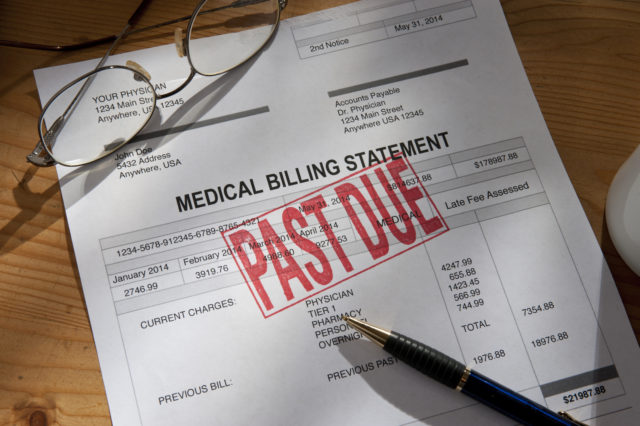
Surprise: It’s not as hard as you think
The No Surprises Act—which prohibits unexpected out-of-network medical charges for procedures at in-network facilities—has the potential to change medical billing as we know it. If all goes well, it will lead to a far less stressful experience for consumers. The financial burdens can no longer be shifted onto the patient, who has too often been left to make sense of a process rife with conflicting information, shocking bills and frustrating dead ends.
The industry still has a long way to go, as patients continue to grapple with understanding (and paying) their healthcare bills. Although major credit reporting firms are moving to strip most medical debt from consumers’ credit reports, an astonishing $88 billion in medical debt appeared on credit reports last year, according to a recent report from the Consumer Financial Protection Bureau. This is why people are often left feeling frustrated, overwhelmed and helpless, unable to navigate the system on their own. In the worst cases, they simply give up, forgoing care altogether.
The No Surprises Act can alleviate some of the complexity that leads to unaffordable surprise medical bills. As healthcare continues to mirror other consumer experiences, patient communications and decisions are moving further upstream—impacting patient expectations around administrative and financial experiences.
Patients deserve high-quality care and better outcomes, as well as equitable, consistent and transparent billing experiences. So how do we get there?
Make a meaningful connection before patients walk through the door
It’s all about the pre-visit experience—everything that happens before a patient receives care. In order to avoid unpleasant surprises in the aftermath of an appointment, there should be clarity and reassurance right from the start. When that happens, trust and confidence are securely in place.
If providers can convey patient financial responsibility early in the billing cycle, missed payments are less likely to occur. Based on a study we did, we know that 37% of consumers simply won’t pay their bill if they don’t understand the process, which turns providers into aggressive pursuers, appearing to shake people down for money.
Not only is this approach off-putting, it’s also ineffective. When providers resort to aggressive bill collection tactics, there’s plenty of administrative waste, and unnecessary expenditures, which ultimately yield only a tiny fraction of revenue for the hospital system. So it winds up hurting patients and providers.
How to eliminate surprise billing
Broadly, providers should take three steps to adhere to the new legislation and ensure surprise billing is truly a thing of the past:
1) Implement solutions to meet (and exceed) consumer expectations.
That means pre-visit tools such as online bill calculators, cost estimates and so on. For example, 90% of consumers say that when they’re deciding where to receive healthcare services, it would be at least “somewhat useful” for providers to post pricing information around expected out-of-pocket costs on the provider website. Another key solution is to have an automated, omnichannel strategy that’s configured to patient preferences and leads to fewer no-shows, such as using text and email notifications.
2) Reduce no-shows by guaranteeing price.
Not only does this reduce the chances that patients will cancel or fail to show up for appointments, but clear cost estimates can incentivize attendance by reassuring patients that they have fair, flexible and viable options for financing and payment. In turn, that builds trust and confidence going into an appointment. In fact, 79% of healthcare consumers say that with a guaranteed price, they’re even willing to pay out-of-pocket costs upfront. And nearly two-thirds say they would likely use an online generator for out-of-pocket costs (for specific services) if it was available to them.
3) Offer flexible payment options.
Imagine a patient’s sigh of relief when they find out no one is coming after them for a balance if they can’t pay in full. Being hit with unpleasant surprises, such as penalty late fees or other unexpected costs, can prove destabilizing.
Offering payment options—such as payment plans and contactless payment options—allow consumers to plan their care better and feel that a provider has their best interests at heart. Mobile payment options are especially popular, due to ease and convenience (especially in the wake of Covid-19). According to one study, 25% of patients are now paying via contactless debit or credit because of Covid-19.
This mode allows patients the flexibility to self-select what works best for their particular circumstances. It’s hassle-free and can be taken care of quickly, securely, and on-the-go.
Above all, flexible payment options help patients feel empowered and in control of their own healthcare journey. (No surprises.) That’s a great outcome all around.
Keep up the good work—though every stage of the care journey, and beyond
Although adhering to the No Surprises Act could lead to better outcomes for all (as providers must provide “good-faith estimates” when calculating medical bills), the response in the healthcare community has been mixed. In thinking about how best to implement the law, the pushback is understandable in such a vast and complex system.
Meeting the criteria of the No Surprises Act is one thing, but it’s another for providers to raise the level of the patient journey beyond what’s required. The rewards? Patient retention and loyalty, and maximizing profitability via increased payment collections. Healthcare consumerism is only growing, and there’s no turning back.
That’s why it’s critical to communicate clearly from the very start of patient-provider interactions, and to engage effectively, offering transparency and warmth throughout. No one wants to feel like they’re just part of a transaction, and we all know that first impressions carry a lot of weight. Making a person feel good before care begins, before they even set foot in a doctor’s office, is a great way to start.
Photo: KLH49, Getty Images








